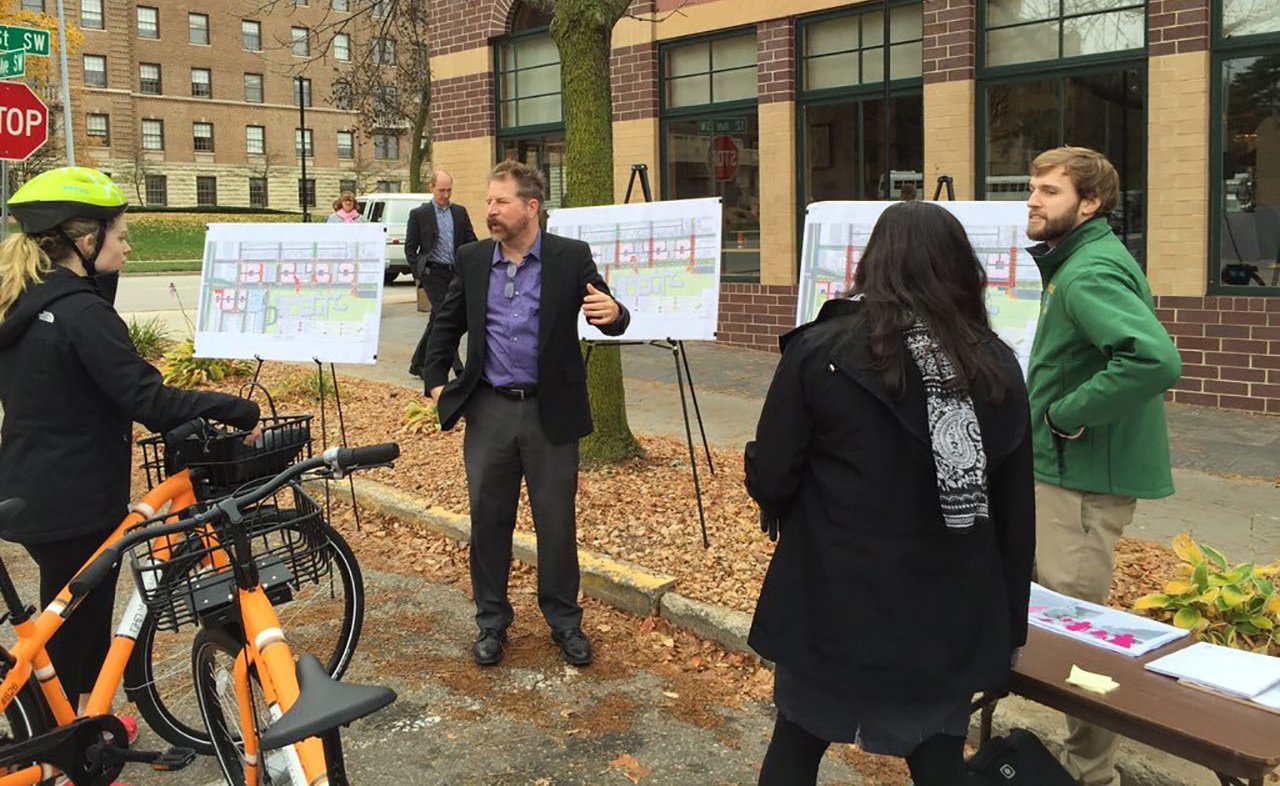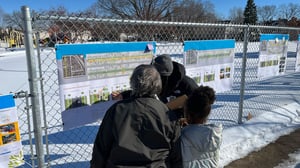To engage stakeholders and build community support, it is crucial to clearly communicate the vision for the project and earn community trust through the planning process. By reaching out to key stakeholders early and often, you increase your chances of securing their support as the project progresses.
Public engagement is a two-way process that involves project leaders working to better understand the needs, values, and goals of the community. This process can generate excitement, improve the project design, and ultimately increase community support for implementation.

 1. Identify the right stakeholders
1. Identify the right stakeholders
Strong coordination between all invested parties is key to the success of any project. To ensure all perspectives are taken into consideration, it is important to identify key stakeholders and understand their roles, needs, and concerns. This will help tailor your outreach efforts and address the issues that matter most to them.
- Property owner − whether a private, public, municipal, or not-for-profit entity, involving the property owner from the onset will allow them to understand and be engaged in the process, helping to ensure a smooth process.
- Local government agencies − can help shape the project to comply with municipal ordinances, utility and site constraints, and secure project funding, including state and federal funds with matching local funds to position the project for implementation.
- Developers − often involved from the start of the project to understand market conditions and opportunities to help craft a project vision that is feasible and realized.
- Economic development groups − local and regional groups can provide valuable guidance regarding current economic conditions and future opportunities for the project to be an asset to businesses and residences.
- Community and neighborhood groups − serve as the voice of the community and can be your biggest advocate in seeing the benefits of the project on the neighborhoods they live and work in.
- Financial groups − depending on the redevelopment plan, financing might need to be secured through private lenders or investment groups.
- Environmental consultants − based on the initial site assessment, this partner could be crucial throughout the project to assist with due diligence (liability protection), implementing an environmental cleanup plan, and ensuring the owner meets all environmental cleanup obligations.
 2. Develop a community engagement plan
2. Develop a community engagement plan
A community engagement plan outlines the vision and goals of the engagement efforts, target audiences, and outreach techniques and tools proposed for your project. Having an engagement plan promotes follow-through and ensures that the right stakeholders and public involvement processes are included throughout the project. The plan should include:
- A list of stakeholders involved in the project or who would benefit from being engaged in the project development and understanding its purpose and impacts.
- The type of outreach efforts, both in-person and virtual, to be used throughout the project.
- The frequency and timing of each phase of the project and corresponding community/ stakeholder outreach and who is responsible for coordinating these efforts.
- A phase that creates a project vision or a visual representation that documents results from the engagement phases and is communicated to stakeholders, regulatory officials, and economic development leaders.
 3. Focus on equitable engagement
3. Focus on equitable engagement
Transparency is now a community expectation for public projects, making traditional community engagement practices insufficient. Equitable engagement must reflect the demographics of the community and place emphasis on engaging those who will be most impacted by the project. It recognizes these past engagement limitations and supplements them with strategies to engage those who have been historically left out. Understanding the impact of a project is crucial in determining the level of community engagement needed. The Environmental Protection Agency (EPA)'s EJscreen tool helps identify areas with disadvantaged populations, potential environmental quality issues, and a combination of environmental/demographic indicators greater than usual. The greater the impact on at-risk or underrepresented populations, the higher level of engagement needed to ensure inclusive, fair, and equitable implementation.
 4. Utilize different engagement tools
4. Utilize different engagement tools
Effective engagement is achieved by using a range of different tools. From in-person and virtual meetings to project blogs, newsletters, and beyond, there are numerous possibilities for communicating information about your project. When choosing engagement tools, it is important to consider the demographics, facilities, and technology available to help ensure that communications are clear, concise, and effective.
Building relationships with stakeholders and listening to their ideas can help establish trust and foster a sense of collaboration. A few examples include:
- Consider hosting community events or workshops to engage stakeholders, gather feedback, and build support for the project. These could include open houses, informational sessions, public forums, or fun events such as festivals or block parties.
- Project committees and workgroups can effectively bring stakeholders together and encourage collaboration.
- Partner with local organizations to help broaden the reach of your engagement efforts and tap into their expertise and resources.
- Meet people where they are. Make it easier for busy community members to engage and participate by hosting pop-up meetings or events in areas where stakeholders are located, or locations frequently visited, such as a business shopping area, downtown event, or local festival.
- Build relationships and address specific, sometimes confidential or sensitive concerns by conducting 1:1 meetings or personal meetings with stakeholders.
- Regular newsletters and project emails can be used to keep stakeholders informed about the project's progress and upcoming events.
- Gather stakeholder comments throughout the planning process by utilizing social media and other online platforms to share updates and information and encourage online stakeholder feedback. Brief but regular online surveys are an effective way to do this.
- Educate stakeholders about the project and its objectives by providing them with information kits.
- Provide stakeholders with access to all the latest information about the project and its progress through a project website.
- Address challenges for underrepresented communities, such as limited internet access and language barriers, by offering alternative engagement methods like in-person meetings, translation services or stakeholder meetings designed for non-English speakers, or outreach through local libraries.

 5. Involve stakeholders early and often
5. Involve stakeholders early and often
Engaging with stakeholders and the community early in the process can help shape public perception. Each stakeholder’s expertise brings a different piece of the vision to the project. This involvement can shed new light on a situation and help resolve conflicts before the project plan has been developed. Waiting until the end of the project to involve stakeholders can lead to redoing certain aspects of a project or, worse, needing to start the engagement process over.
Stakeholders want consistency and transparency, so it's essential to provide regular, accurate project updates to build trust. It is also important to foster a sense of ownership and pride. Find ways to engage stakeholders in hands-on activities, such as site planning/modeling, volunteering with additional project outreach, or assisting with fundraising efforts, to help them feel connected to the project. Recognize and celebrate stakeholders' contributions to the project's success throughout the process.
Stakeholders feel empowered, and team collaboration is most effective when stakeholders have a seat at the table. To facilitate collaboration, provide opportunities for them to participate, such as committee involvement, personal visits, workshops, and interactive tools. This ensures all stakeholders are feeling listened to, involved in planning the project, and engaged in the design and implementation process.
The success of a redevelopment project is a result of effective community communication and stakeholder engagement. By identifying key stakeholders, understanding their needs, and involving them early on, the project can ensure community support and achieve success. With a focus on equitable engagement and the use of different engagement tools, the project can communicate information effectively and increase community support. Developing a project vision or a visual representation that documents results from the engagement process and helps create excitement and a shared community vision for the project.
If you'd like more information on how to effectively involve stakeholders in your next project, we’d love to connect.

Nancy Dosdall, AICP, LEED Green Associate, is a senior planner and project manager with 35+ years of experience in land use planning and entitlement. Nancy is proficient in public engagement and finding common ground amongst stakeholders to develop community-supported plans.

Brea Grace, AICP, NCI is a certified urban and land use planner with 25 years of experience in both public and private sectors. She specializes in urban and waterfront redevelopment and is highly adept at public outreach, project financing, grant writing, and economic development. Brea is passionate about building better communities and leveraging funding sources to help communities achieve their project goals.

.png?width=113&name=SEH_Logo_RGB%20(1).png)
